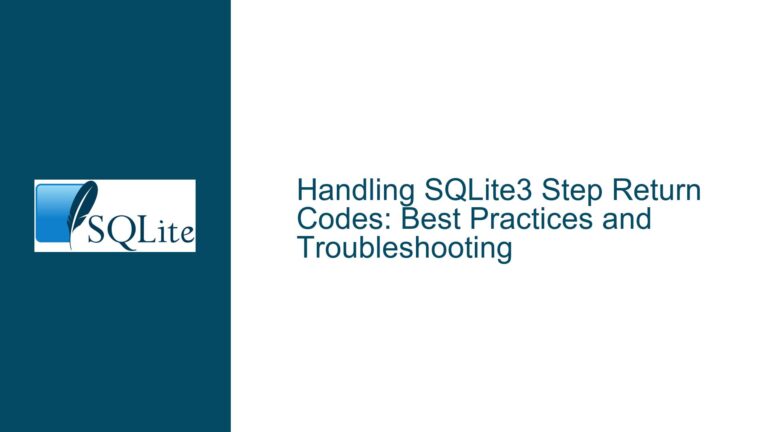Unexpected Results in SQLite WHERE Clause with IS Operator
Issue Overview: Unexpected Behavior in WHERE Clause with IS Operator and CUME_DIST Window Function
The core issue revolves around an unexpected result when using the IS operator in a WHERE clause in conjunction with a CUME_DIST window function within a view. The problem manifests when evaluating the expression ('1')IS(v0.c1) IS FALSE in two different contexts: within a SELECT statement and within a WHERE clause. The results are inconsistent, leading to confusion and potential data integrity issues.
In the provided example, a table t0 is created with a single column c0. A view v0 is then defined, which uses the CUME_DIST window function to calculate the cumulative distribution of values in t0.c0, and appends a constant TRUE value as c1. After inserting a single row into t0, the view v0 is queried in two different ways:
- A
SELECTstatement retrieves all rows fromv0andt0, producing the expected result:1.0|1|x. - A
SELECTstatement with aWHEREclause filtering on('1')IS(v0.c1) IS FALSEreturns no rows, which is unexpected. - A
SELECTstatement evaluating('1')IS(v0.c1) IS FALSEdirectly returns1, indicating that the expression evaluates toTRUE.
This inconsistency suggests a bug in SQLite’s handling of the IS operator within the WHERE clause when used in conjunction with window functions and views. The issue has been confirmed to exist in SQLite versions starting from 3.35.0 and has been fixed in the trunk for the upcoming 3.39.0 release.
Possible Causes: Misinterpretation of IS Operator and Window Function Interaction
The root cause of this issue lies in the interaction between the IS operator and the CUME_DIST window function within the context of a view. The IS operator in SQLite is used to compare two expressions and returns TRUE if they are the same, FALSE if they are different, and NULL if either expression is NULL. However, when used within a WHERE clause, the operator’s behavior appears to be influenced by the presence of the window function, leading to unexpected results.
The CUME_DIST window function calculates the cumulative distribution of a value within a group of values. In this case, it is used to partition the data by t0.c0, which contains only one value ('x'). The function returns 1.0 for the cumulative distribution and appends TRUE as c1. When the expression ('1')IS(v0.c1) IS FALSE is evaluated, it should return FALSE because ('1') is not the same as TRUE. However, the WHERE clause interprets this expression differently, leading to no rows being returned.
This behavior suggests that SQLite’s query planner or optimizer may be mishandling the evaluation of the IS operator in the presence of window functions, particularly when used within views. The issue is further compounded by the fact that the CUME_DIST function returns a floating-point value, which may introduce additional complexities in type comparison and evaluation.
Troubleshooting Steps, Solutions & Fixes: Addressing the IS Operator and Window Function Interaction
To address this issue, it is essential to understand the underlying mechanics of the IS operator and how it interacts with window functions and views in SQLite. The following steps outline the troubleshooting process and potential solutions:
Verify SQLite Version and Configuration: Ensure that the SQLite version being used is 3.39.0 or later, as the issue has been fixed in this release. If an older version is in use, consider upgrading to the latest version. Additionally, verify that the configuration options and compiler settings match those used in the environment where the issue was reported.
Review Query Execution Plan: Use the
EXPLAIN QUERY PLANstatement to analyze how SQLite is executing the query. This will provide insights into how the query planner is handling theISoperator and the window function. Look for any anomalies or unexpected steps in the execution plan that may indicate a misoptimization.Simplify the Query: Break down the query into smaller components to isolate the issue. For example, evaluate the
CUME_DISTfunction separately and compare its output with the expected results. Similarly, evaluate theISoperator outside the context of theWHEREclause to ensure it behaves as expected.Use Explicit Type Casting: Since the
CUME_DISTfunction returns a floating-point value, consider using explicit type casting to ensure consistent comparison. For example, castv0.c1to an integer or string before applying theISoperator. This may help avoid any implicit type conversion issues that could be causing the unexpected behavior.Avoid Window Functions in Views: If possible, avoid using window functions within views, especially when combined with complex operators like
IS. Instead, calculate the window function results in a separate query and use the results in the view. This approach can help isolate any issues related to window function evaluation.Apply the Fix from SQLite Trunk: If upgrading to SQLite 3.39.0 is not immediately feasible, consider applying the fix from the SQLite trunk to the current version. This may involve manually patching the SQLite source code and recompiling the library. However, this approach should be used with caution, as it may introduce other issues or incompatibilities.
Monitor for Future Releases: Keep an eye on future SQLite releases for any additional fixes or improvements related to this issue. The SQLite development team is continuously working on improving the database engine, and future releases may include further enhancements to address similar issues.
Consider Alternative Approaches: If the issue persists or cannot be resolved through the above steps, consider alternative approaches to achieve the desired functionality. For example, use a different operator or function that provides consistent results, or restructure the query to avoid the problematic combination of
ISand window functions.
By following these troubleshooting steps and applying the appropriate solutions, it is possible to address the unexpected behavior in the WHERE clause with the IS operator and window functions in SQLite. The key is to carefully analyze the query execution, simplify the problem, and apply targeted fixes to ensure consistent and accurate results.






